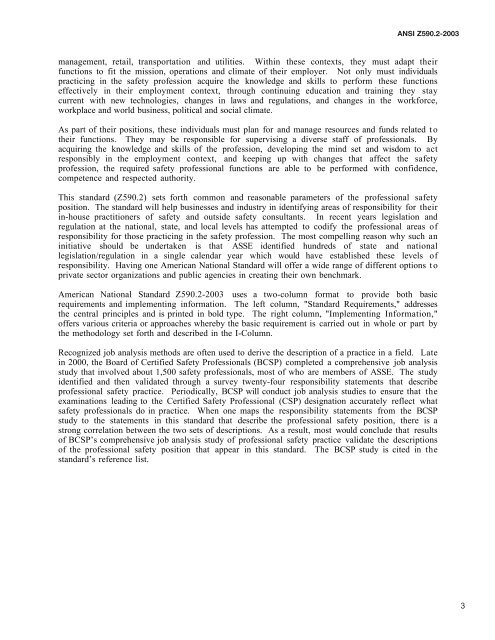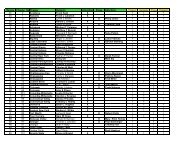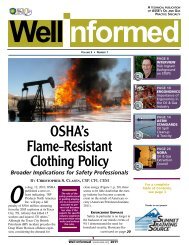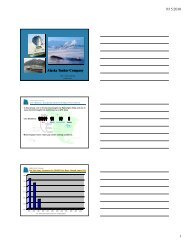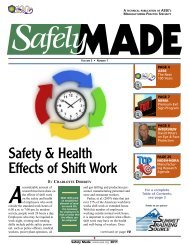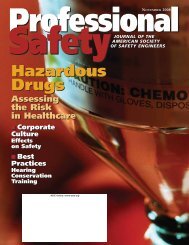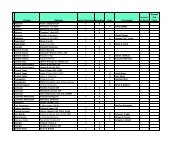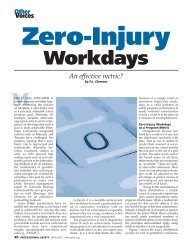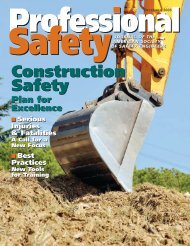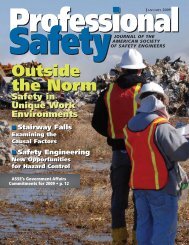ASSE Members - American Society of Safety Engineers
ASSE Members - American Society of Safety Engineers
ASSE Members - American Society of Safety Engineers
You also want an ePaper? Increase the reach of your titles
YUMPU automatically turns print PDFs into web optimized ePapers that Google loves.
ANSI Z590.2-2003<br />
management, retail, transportation and utilities. Within these contexts, they must adapt their<br />
functions to fit the mission, operations and climate <strong>of</strong> their employer. Not only must individuals<br />
practicing in the safety pr<strong>of</strong>ession acquire the knowledge and skills to perform these functions<br />
effectively in their employment context, through continuing education and training they stay<br />
current with new technologies, changes in laws and regulations, and changes in the workforce,<br />
workplace and world business, political and social climate.<br />
As part <strong>of</strong> their positions, these individuals must plan for and manage resources and funds related to<br />
their functions. They may be responsible for supervising a diverse staff <strong>of</strong> pr<strong>of</strong>essionals. By<br />
acquiring the knowledge and skills <strong>of</strong> the pr<strong>of</strong>ession, developing the mind set and wisdom to act<br />
responsibly in the employment context, and keeping up with changes that affect the safety<br />
pr<strong>of</strong>ession, the required safety pr<strong>of</strong>essional functions are able to be performed with confidence,<br />
competence and respected authority.<br />
This standard (Z590.2) sets forth common and reasonable parameters <strong>of</strong> the pr<strong>of</strong>essional safety<br />
position. The standard will help businesses and industry in identifying areas <strong>of</strong> responsibility for their<br />
in-house practitioners <strong>of</strong> safety and outside safety consultants. In recent years legislation and<br />
regulation at the national, state, and local levels has attempted to codify the pr<strong>of</strong>essional areas <strong>of</strong><br />
responsibility for those practicing in the safety pr<strong>of</strong>ession. The most compelling reason why such an<br />
initiative should be undertaken is that <strong>ASSE</strong> identified hundreds <strong>of</strong> state and national<br />
legislation/regulation in a single calendar year which would have established these levels <strong>of</strong><br />
responsibility. Having one <strong>American</strong> National Standard will <strong>of</strong>fer a wide range <strong>of</strong> different options t o<br />
private sector organizations and public agencies in creating their own benchmark.<br />
<strong>American</strong> National Standard Z590.2-2003 uses a two-column format to provide both basic<br />
requirements and implementing information. The left column, "Standard Requirements," addresses<br />
the central principles and is printed in bold type. The right column, "Implementing Information,"<br />
<strong>of</strong>fers various criteria or approaches whereby the basic requirement is carried out in whole or part by<br />
the methodology set forth and described in the I-Column.<br />
Recognized job analysis methods are <strong>of</strong>ten used to derive the description <strong>of</strong> a practice in a field. Late<br />
in 2000, the Board <strong>of</strong> Certified <strong>Safety</strong> Pr<strong>of</strong>essionals (BCSP) completed a comprehensive job analysis<br />
study that involved about 1,500 safety pr<strong>of</strong>essionals, most <strong>of</strong> who are members <strong>of</strong> <strong>ASSE</strong>. The study<br />
identified and then validated through a survey twenty-four responsibility statements that describe<br />
pr<strong>of</strong>essional safety practice. Periodically, BCSP will conduct job analysis studies to ensure that the<br />
examinations leading to the Certified <strong>Safety</strong> Pr<strong>of</strong>essional (CSP) designation accurately reflect what<br />
safety pr<strong>of</strong>essionals do in practice. When one maps the responsibility statements from the BCSP<br />
study to the statements in this standard that describe the pr<strong>of</strong>essional safety position, there is a<br />
strong correlation between the two sets <strong>of</strong> descriptions. As a result, most would conclude that results<br />
<strong>of</strong> BCSP’s comprehensive job analysis study <strong>of</strong> pr<strong>of</strong>essional safety practice validate the descriptions<br />
<strong>of</strong> the pr<strong>of</strong>essional safety position that appear in this standard. The BCSP study is cited in the<br />
standard’s reference list.<br />
3


